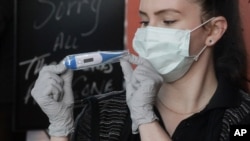There’s a race on to predict where the COVID-19 virus is growing, what social distancing measures are working and when it will be safe to open society again.
But to do that takes data and the ability to detect signals in the noise of information. Governments are turning to tech companies such as Facebook and Google to see if location data might offer help.
One unlikely place to turn: A smart thermometer that is connected to the internet. Fever is one of the common symptoms of the novel coronavirus and capturing fever data – in real time – might be an indicator of where the virus is moving.
More than 100,000 temperatures are taken each day on a Kinsa smart thermometer, which starts at about $35. A user’s temperature connects via Bluetooth and is uploaded to a central database at Kinsa Health, a San Francisco-based firm. The data is aggregated, and the company looks for patterns such as where the seasonal flu is popping up, often weeks ahead of public health organizations, according to the firm.
Rings of outbreak
In mid-March, the company’s data began to see fever clusters in Florida and New York. Kinsa doesn’t know for sure that those were COVID-19 cases, but it’s a signal, said Inder Singh, chief executive of Kinsa Health.
“That’s like a flashlight going off,” he said. “It’s saying, ‘Hey there’s an outbreak. There’s an outbreak here. Come look at it. Send the virologists in. Send the test kits in.’”
The firm created its U.S. Health Weather Map, where people can enter their county to see if atypical fever outbreaks are falling or rising.
Fevers falling
Singh recently looked at his firm’s regional fever data and compared it to places with strict social-distancing measures. His conclusion: social distancing efforts are working.
“It's clear, it's very clear when you start implementing aggressive social distancing activity – stay at home, shelter in place, even bar and restaurant closures – within three to seven days, you see the fever curves level off and start dropping and that’s because you are breaking the chain of infection,” he said.
Leveling off, but still too high
But Singh also is seeing something that is worrisome: fevers holding steady – still higher than normal – even in places where fever cases are leveling off.
“The worry is that there’s small groups of people or small communities of people where virus is being passed around. That could act as a reservoir, that could be a hiding place for COVID-19 and after we relax our social distancing activities, it will start spreading again.”
To be sure, smart thermometers like Kinsa may just offer a sliver of information. Some critics say that these devices give a skewed view of an illness, perhaps because they are owned more by people who are young and affluent.
Still, a smart thermometer’s fever data may be one signal for health officials scrambling to figure out what to address next.










